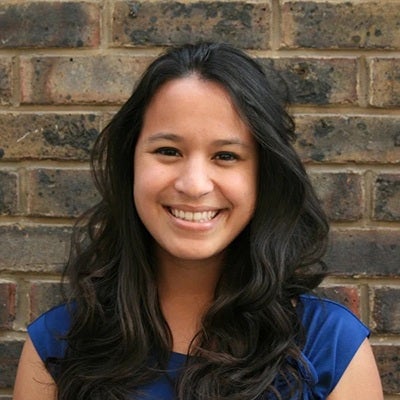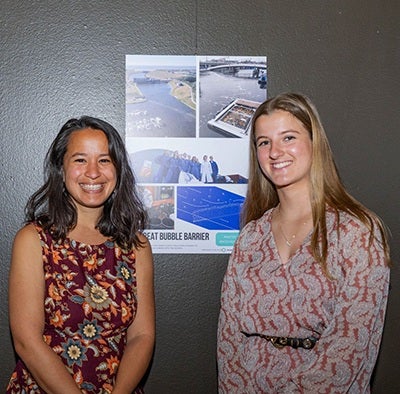
Alumna’s Path Evolves from Engineering to Impact Entrepreneurship
- Jun 11, 2024
- Global Alumni Relations
- by Ellen Stader
As an undergrad at The University of Texas at Austin, Nadia Laabs (B.S. ’08) had no idea of the far-flung places her mechanical engineering degree would take her after she left Austin: from Ohio to South Africa to France and Singapore, then London, and now Portugal. At every stop, her career has taken a surprising turn.

Laabs was no stranger to the wider world even before she became a Longhorn, though. Born in Berlin, she lived there for three months before her father’s work took the family to Saudi Arabia. By the time she landed in Texas at age 13, Laabs was fluent in English, Dutch, German and Spanish, having lived in 10 countries and experienced a range of international education.
“The U.S. was the first place I went to public school. It was a bit of a culture shock because there were different levels of classes,” recalled Laabs. “In international schools, everyone is in the same class. I had to figure that system out.”
Making Her Education Her Own
Once in the United States, Laabs attended Anderson High School in Austin and dived into the city's lifestyle. When the time came to choose a college, though, her thinking diverged from her mother’s long-held dreams. The family had moved to the U.S. expressly for the benefit of Nadia’s education, and her mother had always held an Ivy League school in mind for her.
However, Laabs’ decision to attend UT Austin for engineering was motivated by practical thinking. Aware of the place held by the Cockrell School of Engineering among the nation’s top engineering schools, she also knew her in-state residence and Top 10 percent ranking would guarantee her admission. She struggled to see the advantages of an expensive out-of-state school.
“I said, pragmatically, it doesn't make sense ... UT is a really good school for engineering, and I can get a full ride there,” said Laabs. “I know my mom has basically always done everything to take care of my needs educationally. But, I thought, it just doesn’t make sense to send me to one of those schools when I've got a really, really good school here.”
Lessons Learned in Diapers
As of 2024, a staggering 93 percent of Texas Engineering graduates are employed upon graduation or attend graduate school, largely a result of more than 1,500 employers recruiting Cockrell School graduates annually. Thanks to this vigorous recruiting program, Laabs’ career jumpstarted itself before she even left UT.
“UT Austin has been on my resumé since 2008,” said Laabs. “People would say, ‘That's a really good engineering school, and you must have been really smart to be able to go there.’ I think it's opened up a lot of doors for me.”
In 2008, Procter & Gamble recruited Laabs straight out of Cockrell to work for its Baby Care division in Cincinnati, Ohio — an opportunity whose potential she saw clearly, despite a few reservations.
“I thought, OK, I'll go make diapers in Ohio!” Laabs laughed. “From an engineering standpoint, it was actually a very exciting prospect. People don't understand the complexity in diapers.”

“But to be honest, it wasn't the diapers that got me,” she continued. "It was the company culture. I was really inspired by the people around me. They were so smart, and I thought, ‘I can learn a lot here. Plus, P&G is big, so I can move around.’ ”
Laabs positioned herself to work on entrepreneurial projects at P&G, with a particular focus on sustainability, which gave her a window into a new approach to work and business.
“There was a lot of opportunity because I ended up working in sustainability,” said Laabs. “I thought, ‘This is actually where I can create some change; I can see that impact.’ ”
Her experiences in sustainability and entrepreneurship eventually redirected her from engineering positions to more fluid roles where her interest in service and collaboration could have a greater effect. These also squared perfectly with her global experiences as a child and teenager, when she was exposed to many different cultures and places growing up.
“You see the amazing things around the world; you also see the inequality, the unfairness, the injustice,” said Laabs. “And seeing all the different parallels around the world, you think, ‘Hmm, this doesn't seem right. There's something that's got to be done about this.’ That definitely influenced the line of work that I got into, in terms of being more impact-focused.”
Beginning her first career pivot, Laabs obtained an MBA at the Institut Européen d'Administration des Affaires, or INSEAD — known as “The Business School for the World” — on their campuses in France and Singapore. From there, she leaped into the world of social entrepreneurship.
From Engineer to Entrepreneur
Laabs acknowledged that the jargon of industry phrases like “impact entrepreneurship ecosystems” can be baffling for outsiders, so she offered a primer on some of the language commonly used in the field, also revealing its objectives in the process.
“I came across the term ‘impact entrepreneurship’ (or ‘social entrepreneurship’) in about 2010,” she said. “It was a way of realizing that you can do good not just as a volunteer thing or a hobby, but it can actually be the core of your purpose, career and work — centered around how to use business as a force for good.”

In 2015, with these objectives in mind, Laabs and partners in London co-founded The Impact Collective, a group of socially oriented professionals who work to sustainably solve problems with businesses and communities. Based on a client organization's specific needs, they create customized solutions to help the client make a better impact on the world.
“We ask clients, ‘What are the challenges you face? Does your community suffer from [the unaddressed needs of] an aging population, or forest wildfires, for example? What are the issues you're encountering that you need help with?’ ” Laabs explained. “It's all about going on a journey of discovery beforehand, identifying opportunities and then helping develop solutions with them.”
Focusing the Catch, Expanding the Reach
As she pursued this work, one area that snagged Laabs’ attention was commercial fishing — an industry ripe for a move toward greater sustainability, though not all its practitioners agree. Drawn irresistibly by a lofty mission, Laabs agreed to come in as a co-founder of a nascent company called SafetyNet Technologies.
SafetyNet builds submersible LED lights, cameras and sensors that help fishermen catch only the "target species” of fish they intend to catch, leaving other fish and aquatic life free. These measures have proven to save more fish, help fishermen earn more by reducing discards and fishing time, and protect an increasingly essential food source, along with its marine neighbors.

However, the initial difficulty of convincing fishermen to adopt the new technology taught Laabs an early lesson about the challenges of coming from outside a community, trying to change behaviors within a traditional, conservative industry.
“Trying to get the industry to adopt our technology was definitely one of the biggest challenges,” Laabs admitted with a laugh. “I was super naïve, because I didn't know anything about the fishing industry [and went] in there with no background, saying, ‘Hey, fishermen, you could be fishing better!’ ”
Still, Laabs and her partners believed deeply in the benefits their company could offer, so they leveraged their creativity and perseverance, tinkering with SafetyNet’s message and approach until fishermen began to consider their proposals. Eventually, the company found partners who were ready for change within the industry — and when those partners started seeing savings and healthier fishing grounds as a result, others came on board.
“The biggest challenge is always trying to ... inspire the mentality to change,” Laabs reflected. “How do you change mindsets when you think you have a better solution, that can have a better social or environmental impact?”
Take Advantage of All UT Offers
When Laabs looks back on the circuitous career path she’s traveled, she sees that much of it began at UT, with options created by her degree from the Cockrell School.
“I was fortunate with the fact that I went to UT and did engineering, which opened many doors for me in terms of opportunities and jobs. I actually had the luxury of choosing where I wanted to work,” Laabs said.
Laabs has remained connected with the University in numerous ways over the years, first corresponding with scholarship donors and supporters as she began her career, and later serving on recruiting committees that brought other Longhorns to her company.
“I was on the UT recruiting team at P&G for five years,” she said. “I got to go back at least once a year to recruit UT students to come work with us. Seeing the really smart students at UT and being able to provide them the opportunity of a career at P&G was something I really enjoyed.”
Upon moving to London, Laabs also connected with the massive network of Longhorns for Life via the UT alumni association in that city. She looks forward to finding other points of connection with her alma mater, such as lending her entrepreneurial expertise to emerging business owners from across the world who train and network through UT Austin’s Global Programs and Innovations unit.
For current Longhorns, she left some parting advice: Take advantage of all the University has to offer, and don’t focus every atom of energy on your major.
“Don't think that your whole career will be based on your degree,” Laabs said. “One of the biggest advantages of UT is its size and how much opportunity it holds. So I would say to students: explore.”
